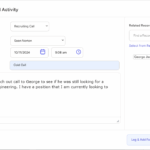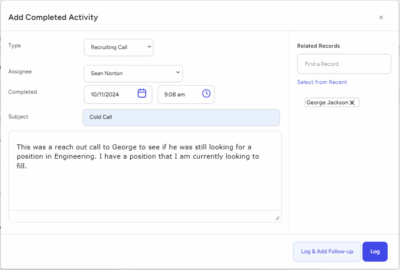In the fast-paced world of recruitment, staying ahead of the curve is essential. With technological advancements revolutionizing every industry, it comes as no surprise that the recruitment sector is also experiencing a transformative wave, thanks to artificial intelligence or AI recruiting software and machine learning (ML).
In this comprehensive exploration, we’ll explore the intricate workings of AI and ML in recruitment, unraveling their multifaceted impact on efficiency, candidate matching, bias reduction, and the evolving landscape of modern recruiting.
Understanding AI Recruiting Software
Gone are the days of manual resume screening and labor-intensive candidate matching. AI recruiting software has emerged as a game-changer, revolutionizing the hiring process from start to finish.
These advanced systems leverage AI and ML algorithms to automate repetitive tasks, analyze vast amounts of data, and make data-driven decisions, ushering in a new era of efficiency and precision in recruitment.
1. Automated Candidate Screening
One of the most time-consuming aspects of recruitment is screening resumes. AI-driven systems can swiftly scan resumes and applications, filtering out candidates who don’t meet the job requirements. By analyzing keywords, skills, experience, and other relevant factors, these systems ensure that only the most qualified candidates make it through to the next stage of the hiring process. This not only saves recruiters valuable time but also ensures a more efficient and fair screening process.
Automated screening also enables recruiters to handle high volumes of applications without sacrificing quality. Whether it’s for entry-level positions or executive roles, AI-powered screening ensures that every candidate receives a fair evaluation based on objective criteria. Additionally, by leveraging historical data on successful hires and performance metrics, AI algorithms can continuously learn and refine their screening criteria, further enhancing their effectiveness over time.
2. Enhanced Candidate Matching
Matching the right candidate to the right job is a complex task that requires careful consideration of various factors, including skills, experience, cultural fit, and more. AI and ML algorithms excel at this task by analyzing data from resumes, job descriptions, and candidate profiles to identify the best possible matches. By considering both hard skills and soft skills, these systems can significantly improve the quality of hires and reduce turnover rates.
Traditional methods of candidate matching often rely on keyword matching or manual assessments, which can overlook subtle nuances and nuances. AI-powered matching algorithms, on the other hand, take a holistic approach, considering a wide range of factors to ensure compatibility between candidates and roles. By leveraging advanced data analysis techniques, such as natural language processing (NLP) and semantic analysis, these algorithms can identify patterns and correlations that human recruiters might miss, resulting in more accurate and reliable candidate recommendations.
3. Predictive Analytics
Predicting candidate success is a challenging endeavor, but AI-powered recruitment software makes it possible. By analyzing historical data on successful hires and performance metrics, these systems can identify patterns and trends that predict future success. This enables recruiters to make more informed decisions and focus their efforts on candidates with the highest likelihood of success.
Predictive analytics can be applied at various stages of the hiring process, from identifying high-potential candidates to forecasting future hiring needs. By leveraging AI and ML algorithms, recruiters can gain valuable insights into candidate performance, retention rates, and other key metrics, enabling them to optimize their hiring strategies and make data-driven decisions.
Machine Learning in Recruitment
While AI plays a significant role in automating processes and making data-driven decisions, Machine Learning takes it a step further by continuously learning and improving over time.
Here’s how ML is revolutionizing the recruitment industry:
1. Resume Parsing and Keyword Extraction
ML algorithms can parse resumes and extract relevant information such as skills, experience, education, and certifications. This not only saves recruiters time but also ensures that no valuable information is overlooked. By continuously learning from new data, ML algorithms can improve their accuracy and efficiency over time.
Resume parsing is a crucial step in the recruitment process, as it enables recruiters to quickly assess candidates’ qualifications and suitability for a role. Traditional resume parsing techniques often rely on predefined rules and templates, which can be rigid and prone to errors. ML-powered parsing algorithms, however, can adapt to different resume formats and languages, ensuring robust performance across diverse candidate profiles.
2. Personalized Candidate Recommendations
Every job and every candidate is unique, and ML algorithms understand this better than anyone. By analyzing past hiring decisions and candidate interactions, these algorithms can generate personalized recommendations tailored to each job opening. This not only improves the candidate experience but also increases the likelihood of finding the perfect match.
Personalized recommendations leverage a combination of historical data, candidate preferences, and job requirements to identify the most relevant candidates for a given role. By taking into account factors such as career progression, location preferences, and cultural fit, ML algorithms can deliver highly targeted recommendations that resonate with both candidates and hiring managers. This not only streamlines the recruitment process but also enhances the quality of hires, leading to better long-term outcomes for organizations.
3. Bias Reduction
One of the biggest challenges in recruitment is unconscious bias. ML algorithms can help address this issue by removing human bias from the hiring process. By focusing solely on objective criteria such as skills and experience, these algorithms ensure a fair and unbiased selection process, leading to more diverse and inclusive hiring practices.
Bias reduction is a critical consideration for organizations seeking to build diverse and inclusive workforces. Traditional hiring practices, such as relying on gut instincts or subjective assessments, can inadvertently perpetuate biases and stereotypes. ML-powered algorithms, however, are trained on diverse datasets and are designed to prioritize meritocracy and fairness. By standardizing the evaluation process and focusing on relevant criteria, these algorithms help organizations build more equitable and inclusive workplaces.
Advanced AI Recruiting Software Features
At the heart of modern recruiting is the applicant tracking system (ATS), a software application designed to streamline the recruitment process. However, not all ATS systems are created equal. Here are some advanced features to look for in an AI-powered ATS:
1. Natural Language Processing (NLP)
NLP enables ATS systems to understand and interpret human language, allowing for more intuitive interactions with candidates and recruiters. From parsing resumes to conducting automated interviews, NLP-powered ATS systems enhance the user experience and improve efficiency.
NLP-powered ATS systems can extract valuable insights from unstructured data, such as candidate resumes and job descriptions. By analyzing text for sentiment, tone, and context, these systems can provide deeper insights into candidate qualifications and suitability for a role. Additionally, NLP algorithms can facilitate more natural and engaging interactions between candidates and recruiters, improving the overall candidate experience and increasing engagement rates.
2. Candidate Relationship Management (CRM)
A CRM module within an ATS allows recruiters to manage relationships with candidates more effectively. By tracking interactions, scheduling follow-ups, and sending personalized communications, recruiters can build stronger connections with candidates and maintain a talent pipeline for future opportunities.
CRM functionality enables recruiters to track the entire candidate journey, from initial contact to onboarding and beyond. By centralizing candidate data and communications, CRM modules provide recruiters with a holistic view of each candidate, enabling them to personalize their interactions and tailor their outreach strategies accordingly. This not only improves candidate engagement but also enhances the overall candidate experience, leading to higher satisfaction rates and increased retention.
3. Real-time Analytics and Reporting
Data-driven decision-making is essential in recruitment, and real-time analytics and reporting features provide recruiters with the insights they need to optimize their hiring process. From tracking key metrics such as time-to-fill and cost-per-hire to identifying bottlenecks and areas for improvement, these features empower recruiters to make informed decisions and drive better outcomes.
Real-time analytics and reporting enable recruiters to monitor the performance of their hiring process in real-time, allowing them to identify trends and patterns as they emerge. By visualizing data in intuitive dashboards and reports, recruiters can quickly identify areas of strength and weakness, enabling them to take corrective action and improve overall efficiency. Additionally, real-time analytics empower recruiters to make proactive decisions, such as adjusting sourcing strategies or reallocating resources, to stay ahead of changing market conditions.
AI and Machine Learning have transformed the recruitment industry, revolutionizing the way organizations find, attract, and hire top talent. From automated candidate screening to personalized recommendations and bias reduction, these technologies offer a host of benefits that improve efficiency, accuracy, and fairness in the hiring process.
By embracing advanced ATS features and leveraging the power of AI recruiting software and machine learning, tech-savvy agencies can stay ahead of the competition and unlock the full potential of modern recruiting. Embrace the future of recruiting with AI-powered software and elevate your hiring process to new heights. With AI and ML as allies, the possibilities are limitless, and the talent pool is yours to explore.








